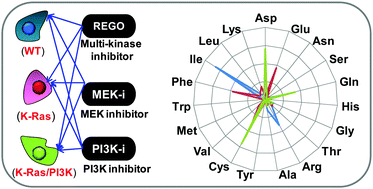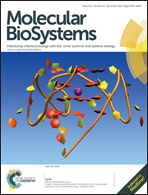Effect of oncogene activating mutations and kinase inhibitors on amino acid metabolism of human isogenic breast cancer cells†
Abstract
We investigated the changes in amino acid (AA) metabolism induced in MCF10A, a human mammary epithelial cell line, by the sequential knock-in of K-Ras and PI3K mutant oncogenes. Differentially regulated genes associated to AA pathways were identified on comparing gene expression patterns in the isogenic cell lines. Additionally, we monitored the changes in the levels of AAs and transcripts in the cell lines treated with kinase inhibitors (REGO: a multi-kinase inhibitor, PI3K-i: a PI3K inhibitor, and MEK-i: a MEK inhibitor). In total, 19 AAs and 58 AA-associated transcripts were found to be differentially regulated by oncogene knock-in and by drug treatment. In particular, the multi-kinase and MEK inhibitor affected pathways in K-Ras mutant cells, whereas the PI3K inhibitor showed a major impact in the K-Ras/PI3K double mutant cells. These findings may indicate the dependency of AA metabolism on the oncogene mutation pattern in human cancer. Thus, future therapy might include combinations of kinase inhibitors and drug targeting enzymes of AA pathways.


 Please wait while we load your content...
Please wait while we load your content...